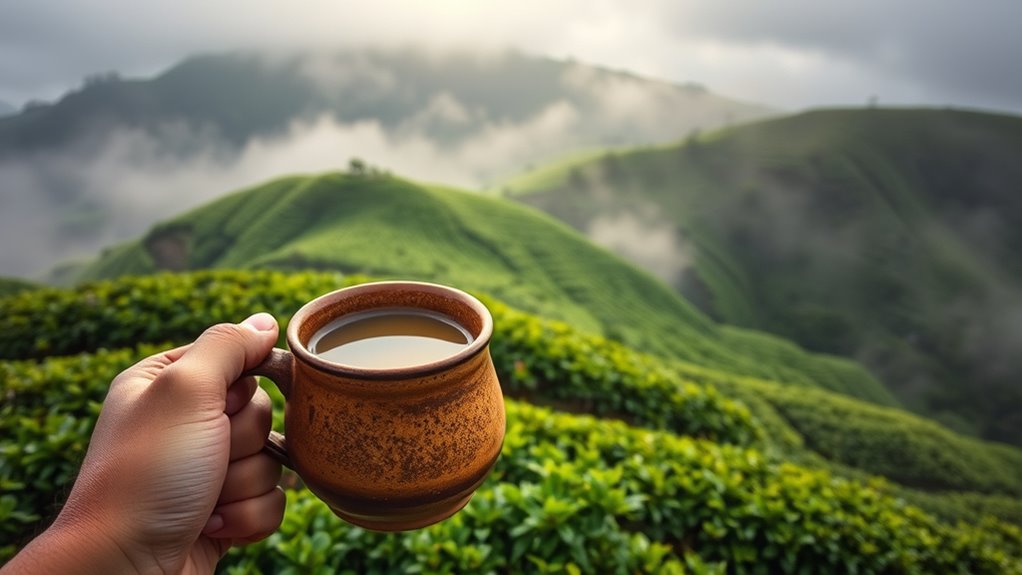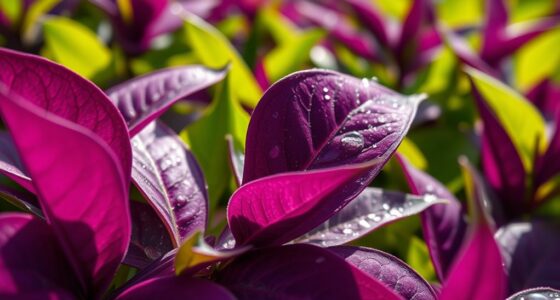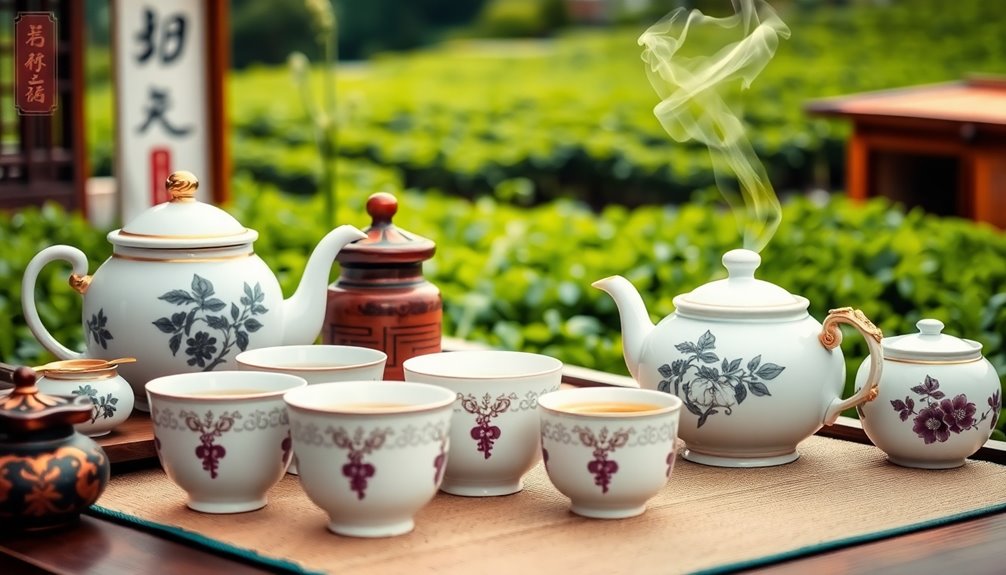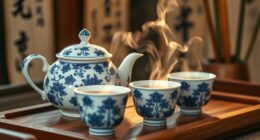Darjeeling’s misty mountain environment plays a key role in shaping the tea’s delicate flavor and aroma. The frequent fog keeps the leaves hydrated and slows their growth, allowing complex, floral notes to develop. This microclimate also traps cool air and maintains high humidity, which enhances the tea’s subtle nuances. If you want to understand how these mountain moods create Darjeeling’s signature finesse, keep exploring the fascinating journey from mountain to mug.
Key Takeaways
- The frequent fog and mist in Darjeeling’s mountains retain moisture and hydrate tea leaves, enhancing delicate flavor development.
- Cooler mountain temperatures slow leaf maturation, allowing complex, nuanced flavors to form during growth.
- The microclimate created by elevation and mist promotes floral and aromatic notes unique to Darjeeling tea.
- Misty conditions extend the growth cycle, enabling deeper flavor and aroma profiles in the harvested leaves.
- The mountain environment preserves the tea’s signature lightness and aromatic qualities from cultivation to brewing.
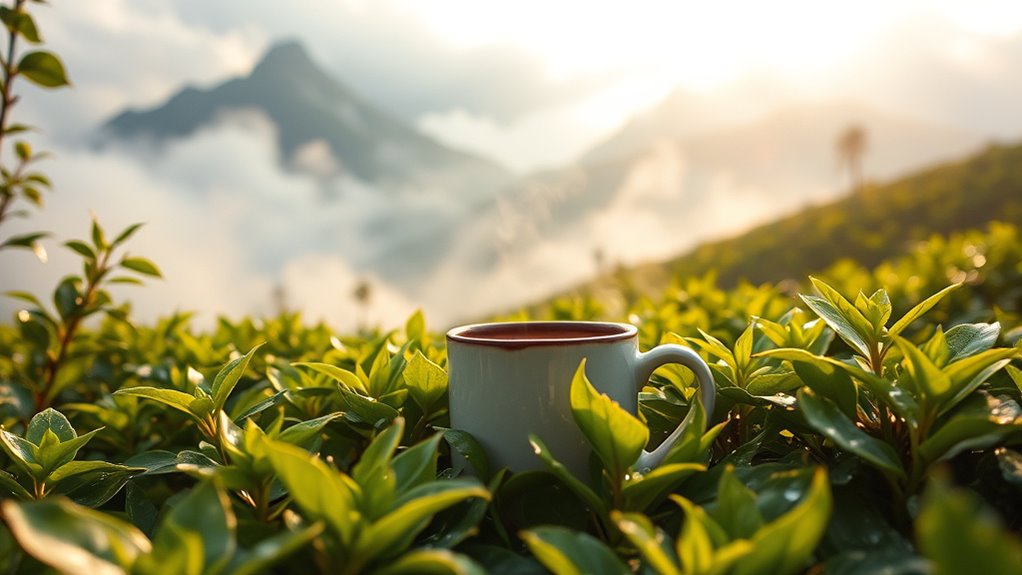
Have you ever wondered how mountain-grown coffee makes its way into your favorite mug? Well, the same idea applies to Darjeeling tea, where the journey begins high up in the mountains. The unique environment of Darjeeling plays a vital role in shaping the flavor of its tea, and understanding this process starts with tea cultivation in a mountain climate. The region’s elevation, combined with its cool temperatures and misty conditions, creates an ideal setting for growing tea leaves that are rich in flavor and aroma. As you sip your cup, remember that the mountain climate influences every aspect of the tea, from leaf quality to taste. This carefully maintained microclimate also contributes to the distinctive aroma that makes Darjeeling teas so highly prized worldwide.
Tea cultivation in Darjeeling depends heavily on its mountain climate. The altitude, which ranges from about 600 to 2,000 meters above sea level, provides a natural advantage. Cooler temperatures slow down the growth of tea plants, allowing the leaves to develop complex flavors over time. The mountains also bring frequent fog and mist, which help retain moisture and keep the leaves hydrated. This consistent humidity encourages the growth of tender, young leaves, which are prized for their delicate taste and floral notes. The combination of high elevation and mist creates a microclimate that is hard to replicate elsewhere, giving Darjeeling tea its signature lightness and distinctive aroma.
The high elevation and misty climate give Darjeeling tea its unique flavor and aroma.
The mountain climate doesn’t just influence the flavor; it also impacts how tea is cultivated. Farmers carefully select the best spots where the climate provides ideal conditions—steep slopes that drain well and retain moisture, protected valleys that catch the cool mountain air, and shaded areas that reduce direct sunlight. These factors ensure the tea plants thrive in their mountain environment. The cool temperatures slow down the maturation process, which enhances the complexity of the flavors. This slow growth allows the leaves to produce more nuanced, layered tastes that many tea connoisseurs cherish.
As you enjoy your cup of Darjeeling, it’s essential to appreciate how the mountain climate shapes its character. The mist, the cool air, and the high altitude all work together to create a unique terroir. This environment not only influences the cultivation process but also guarantees that each harvest reflects the distinct qualities of the mountain’s climate. From the careful selection of planting sites to the delicate plucking of young leaves, every step in the journey from mountain to mug is deeply influenced by the region’s unique weather patterns. So, next time you take a sip, remember that it’s the mountain’s climate that grants Darjeeling tea its unparalleled finesse, connecting you to the high, misty peaks where it all begins.
Frequently Asked Questions
How Does Altitude Affect Tea Leaf Chemistry?
Altitude effects markedly influence leaf chemistry, which in turn impacts your tea’s flavor. As you go higher, cooler temperatures slow plant growth, leading to more concentrated and complex leaf chemistry. This results in teas with brighter, more nuanced flavors. You’ll notice that teas from higher altitudes often have a delicate aroma and vibrant taste, showcasing how altitude directly shapes the chemical makeup of tea leaves and enhances your overall tea experience.
What Are the Best Harvesting Times in Darjeeling?
Imagine the thrill of tea harvest festivals in Darjeeling, where timing is everything. You should plan your visit during the plucking season from March to June or September to November for the best leaves. During these times, skilled plucking techniques guarantee quality. The right harvest timing captures the unique flavor, with early plucks offering freshness and later ones deepening character, making your tea experience truly exceptional.
How Does Soil Composition Influence Flavor?
You’ll notice that soil composition greatly influences Darjeeling tea’s flavor. The soil minerals and terroir effects give each tea a unique character, with rich mineral content adding depth and complexity. When the soil is well-drained and fertile, it promotes healthy growth and vibrant flavors. By understanding how soil impacts taste, you can better appreciate the distinct qualities of Darjeeling teas and how their environment shapes each cup.
Are There Specific Weather Patterns That Enhance Tea Quality?
Imagine the gentle whisper of weather embracing your tea leaves. Specific weather patterns, like consistent rainfall influence, create ideal conditions for tea leaf oxidation, enhancing flavor depth. Light, misty mornings and cool, damp afternoons nurture delicate nuances, elevating quality. When rainfall is balanced, it subtly amplifies the tea’s character, making each sip a poetic reflection of nature’s tender touch, transforming ordinary leaves into extraordinary experiences.
How Do Traditional Plucking Methods Impact Flavor Profiles?
Your traditional plucking methods, involving selective harvesting techniques and specific plucking patterns, directly influence the tea’s flavor profile. By hand-picking only the tender leaves and buds, you maintain the tea’s delicate qualities, resulting in a nuanced, aromatic brew. Consistent harvesting techniques guarantee uniformity, while the plucking patterns affect the leaf quality. This careful approach enhances the unique character and freshness of Darjeeling tea, making each cup a refined experience.
Conclusion
So, next time you sip your Darjeeling, remember it’s not just a fancy brew but a high-altitude masterpiece shaped by mist, patience, and a touch of Himalayan magic. Who knew that a little fog could turn plain leaves into a royal brew? Cheers to nature’s sneaky artistry—proof that sometimes, the best things in life really do come from a cloud-covered mountain. Now, go ahead, savor that elusive sip of perfection.

